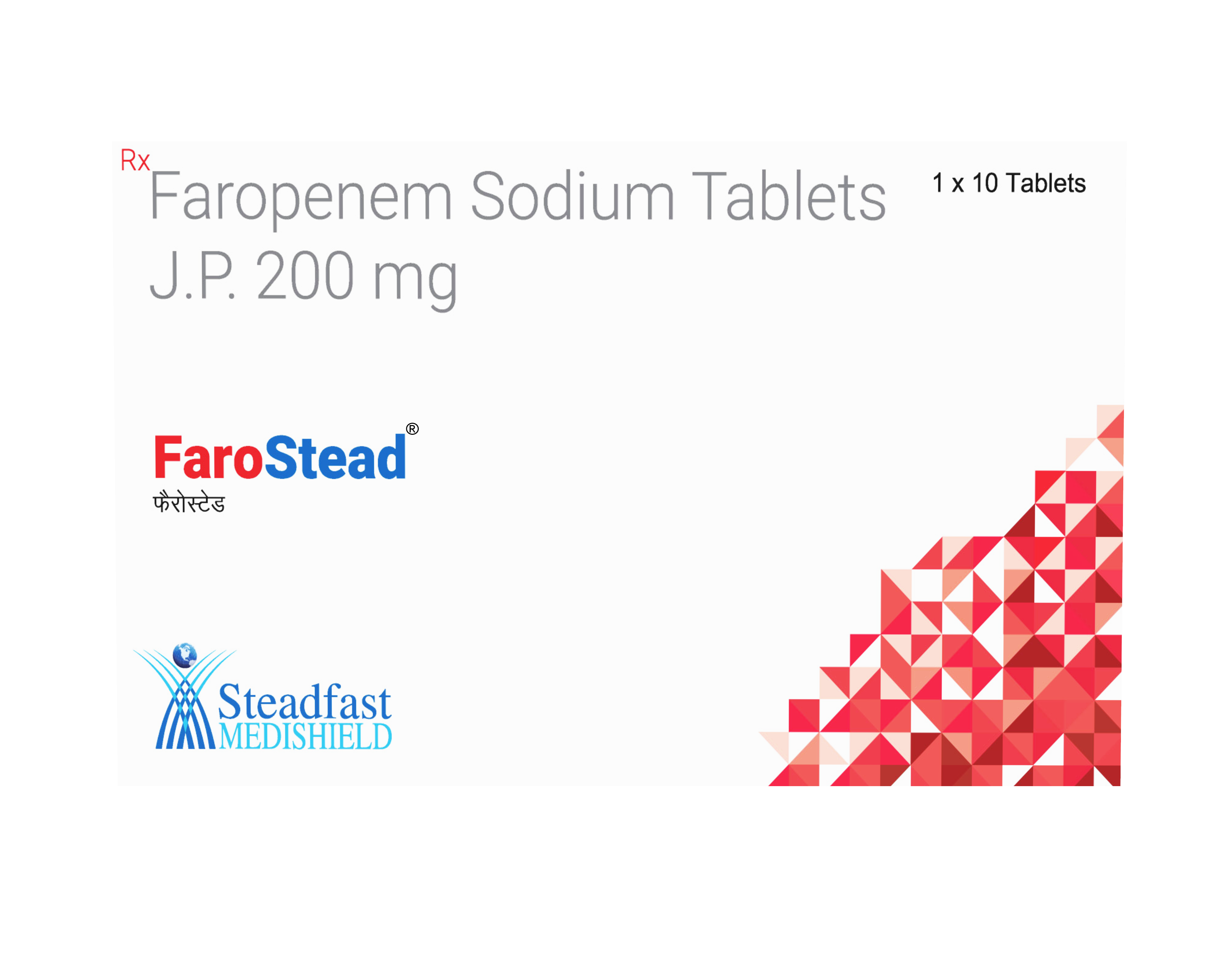COMPOSITION
Each film coated tablet contains:
Faropenem Sodium Hydrate J.P.
Equivalent to Faropenem ……………………………… 200 mg
Colours: Ferric oxide (Red) U.S.P.- N.F. & Titanium Dioxide I.P
DOSAGE FORM
Oral Tablet
PHARMACOLOGY
Pharmacodynamics
Faropenem is a new oral penem which shows broad antibacterial activity against both aerobic and anaerobic gram-positive and gram-negative bacteria. Faropenem is bactericidal, with a strong affinity for the high molecular penicillin-binding proteins (PBPs) of the cell wall, which is essential for the multiplication of bacilli; it, thus, acts by inhibiting the cell wall synthesis. Faropenem is highly stable against various beta-lactamases and binds preferentially to the PBPs, 2 and 1A, of Escherichia coli (E. coli).
Microbiology
Faropenem is found to be active against Enterococcus faecalis, Neisseria gonorrhoeae, Neisseria meningitides, Haemophillus influenza (both beta lactamase negative and beta lactamase positive), Moraxella catarrhalis (Streptococcus pneumoniae, Streptococcus pyogenes, Staphylococcus saprophyticus, Staphylococcus epidermidis, Group A Streptococci, Group B Streptococci, Streptococcus milleri, Streptococcus viridans, Staphylococcus aureus (oxacillin sensitive), Enterococcus faecium, E. coli, Klebsiella spp., Proteus mirabilis, Citrobacter spp., Salmonella spp., Shigella spp., Providentia stuartii, Bacteroides fragilis, Clostridium perfringens, and Peptostreptococcus spp.
Faropenem is less active against the following:
Citrobacter freundii, Proteus mirabilis, Enterobacter spp., Proteus vulgaris, and Morganella morganii.
Pharmacokinetics Absorption
At a single dose of 300 mg in normal healthy adults after meals, the average Tmax was delayed by about 1 hour, but Cmax, AUC and urinary recovery were not different from those in the fasting state. In a multiple dose study with 400 mg t.i.d., the Cmax on days 1, 4, and 7 (1st, 10th and 19th administration) were 5.5, 4.3, and 4.8 microg/ml, respectively. The respective AUCs were 12.5, 10.1, and 12.2 microg./ml, demonstrating no cumulative effect.
Average pharmacokinetic parameters of Faropenem on single-dose administration on empty stomach in normal healthy adults (average ± SD)
|
n |
Cmax (μg/ml) |
Tmax (h) |
T1/2 (h) |
AUC |
|
|
150 mg/person (empty stomach) |
6 |
2.36 + 1.01 |
0.96 + 0.46 |
0.76 + 0.14 |
3.95 + 2.06 |
|
300 mg/person (empty stomach) |
6 |
6.24 + 2.86 |
1.04 + 0.40 |
0.85 + 0.23 |
11.73 + 8.34 |
|
600 mg/person (empty stomach) |
6 |
7.37 + 1.97 |
1.42 + 0.49 |
1.08 + 0.19 |
19.59 + 6.37 |
|
300 mg/person (after meals) |
6 |
4.25 + 1.58 |
2.08 + 0.49 |
1.01 + 0.22 |
9.75 + 4.63 |
Distribution:
Faropenem was found in the sputum of patients, fluid that oozes at the time of tooth extraction, tonsil tissues, maxillary sinus, mucous membrane tissues, female genital organ tissues, eyelids, subcutaneous cell tissues and prostate tissues.
Metabolism and Excretion
Before excretion in the urine, the absorbed Faropenem gets metabolized by dehydropeptidase-I (DHP I), which is present in the kidneys. The metabolites are found in the blood and the urine. The metabolites do not demonstrate antibacterial activity. Faropenem is primarily excreted through the kidneys and the rate of excretion in the urine (0 ~ 24 hours) of 150, 300, and 600 mg (given on an empty stomach to normal healthy adults) was 3.1 ~ 6.8%. The highest concentration in the urine was 21.7, 55.6, and 151.5 μg/ml, respectively, in 0–2 hours; after 12 hours, it was almost reduced to nil.
Pharmacokinetics in special population
Elderly: There is an increase in half-life.
Renal insufficiency: In patients with renal impairment, it was found that the plasma concentration of the drug is increased and the half-life extended.
INDICATIONS:
FaroStead tablets are indicated in the treatment of Respiratory tract infections, Urinary tract infections, Skin and skin structure infections and Gynecological infections.
DOSAGE AND ADMINISTRATION
|
Indication |
Dosage |
|
Upper respiratory tract infections |
150 mg – 200 mg t.i.d. |
|
Lower respiratory tract infections |
200 mg – 300 mg t.i.d. |
|
ENT infections |
200 mg – 300 mg t.i.d. |
|
Genito-urinary infections |
200 mg – 300 mg t.i.d. |
|
Skin and skin structure infections |
150 mg – 200 mg t.i.d. |
|
Obstetric or Gynecological infections |
150 mg – 200 mg t.i.d. |
Duration of Treatment:
The dose/duration of treatment depends upon the severity of infection, clinical response, age of the patients, symptoms and bacteriological findings.
CONTRAINDICATIONS:
Faropenem is contraindicated in patients with known hypersensitivity to any of the components of this product or to other drugs in the same class, or in patients who have demonstrated anaphylactic reactions to beta-lactams.
WARNINGS AND PRECAUTIONS:
Faropenem should be administered with caution in the following:
Patients with a history of hypersensitivity to penicillin, cephem or carbapenem drugs. There is a risk of occurrence of anaphylactic shock; a thorough medical history should be taken.
Patients with a family history of atopy.
Patients with renal insufficiency. The dosage should be reduced or the interval between doses should be increased.
Patients with poor oral intake or poor general state (since there are cases that show symptoms of vitamin K deficiency, proper monitoring should be done).
Diarrhea and loose bowel movement are frequently reported with Faropenem. In case it occurs, appropriate measures, such as discontinua- tion of Faropenem, etc., should be taken.
General: FaroStead contains lactose, patients with rare hereditary problems of galactose intolerance, the Lapp lactase deficiency or glucose galactose malabsorption should not take this medicine.
DRUG INTERACTIONS:
Imipenem and Cilastatin sodium combination: It has been reported that in animal studies (rat), the concentration of Faropenem in the blood increases. It is due to the obstruction of metabolic fermentation by Cilastatin.
Furosemide: It has been reported in animal studies (dog), that the kidney toxicity of Faropenem increases.
Sodium valproate: It has been reported that due to joint usage with carbapenem drugs (Meropenem, Panipenem and Imipenem-Cilastatin sodium), the concentration of valproic acid in the blood reduces, and there is a recurrence of epileptic fits.
Renal Impairment:
In patients with renal impairment, it was found that the plasma concentrations of the drug are increased and the half-life is extended.
Pregnancy:
Safety regarding therapy during pregnancy has not been established. In pregnant women or expectant mothers, the medicine should be given only if the benefits of the treatment are greater than the risks involved.
Lactation:
Faropenem is excreted in human milk. Therefore, Faropenem should be given to nursing mothers only if the benefits outweigh the risks.
Paediatric use:
Safety regarding therapy in infants has not been established.
Geriartric use:
The half-life of Faropenem is prolonged in the elderly and this may be due
to a decline in kidney functions, which results in high plasma concentrations- tions. Therefore, in the elderly, start with a dose of 150 mg and monitor the patient for any undesirable effects.
Be cautious as diarrhoea and loose bowels in aged people may lead to general degeneration of health, therefore if these symptoms are observed stop the medication and take appropriate measures. The aged persons are prone to bleeding or haemorrhage due to vitamin K deficiency.
UNDESIRABLE EFFECTS:
Faropenem is generally well tolerated. The most frequently reported adverse reactions are diarrhoea, abdominal pain, loose bowel movements, nausea and rash.
The following adverse reactions have also been observed:
- Shock (less than 0.1%), pseudo anaphylactic symptoms: it may cause a shock and symptoms of anaphylaxis, so observe carefully. In case of pain, oral abnormality or heaves, difficulty in breathing, dizziness, urge to excrete the bowels, tinnitus, generalized flushing, angioedema, perspiration, low blood pressure etc. Stop the medication and take appropriate steps.
- Acute renal failure: In case of acute renal failure etc., severe symptoms of dysfunction of kidney are observed, but when it becomes abnormal, stop the medication and take appropriate measures.Severe colitis accompanied with bloody stool of pseudomembranal colitis: Patient has to be under careful examination as severe colitis may appear, along with bloody stool due to pseudomembranal colitis etc. If the stomachache and diarrhea persist, stop the medication immediately and take appropriate measures.
- Mucocutaneous-ocular syndrome (Stevens Johnson syndrome): Please observe carefully as mucocutaneous-ocular syndrome (Stevens Johnson syndrome), toxic epidermal necrosis (Lyell syndrome) and Stevens-John- son syndrome may appear, therefore when such symptoms are indicated, stop the medication immediately and take appropriate measures like administering the medicine for adrenal cortex hormone, etc.
- Interstitial Pneumonia: in case of symptoms such as pyrexia, cough, breathing problems, abnormalities in the chest x-ray are revealed along with interstitial pneumonia, stop the medication immediately and take appropriate measures like administering the medicine for adrenal cortex hormone etc.
- Liver function disorder, Jaundice: Observe closely by taking periodic tests etc. because rise in the levels of AST (SGOT), ALT (SGPT), ALP etc., will be indicated along with jaundice, hence in case of abnormality, stop administering the medication and take appropriate steps.
- Agranulocytosis: There can be risk of agranulocytosis so be cautious. In case of abnormality, stop the medication and take steps as appropriate.
Striated muscle softening, Rhabdomyolysis: Rhabdomyolysis has the symptoms of muscular pain, lethargy, increase in CK (CPK), rising level of myoglobin in blood and urine can occur, which can lead to severe kidney dysfunction like renal failure. When these kind of symptoms appear stop the medication and take appropriate steps.
Pulmonary infiltrates with eosinophilia (PIE) syndrome: The possibility of PIE syndrome has been reported along with the increase in acidocytes in case of symptoms such as pyrexia, cough, breathing problems, abnormality in the chest x-ray, stop the medication immediately and take appropriate measures like administering the medicine for adrenal cortical hormone, etc.
Hypersensitivity reactions: rash, pyrexia, redness, hives, red spots on the skin, etc.
Abnormal laboratory findings: increase in liver function tests (ALT, AST, bilirubin, LDH, etc.), eosinophilia, increase in BUN, Creatinine, changes in granulocyte and platelets.
Vitamin deficiency: Symptoms of vitamin K deficiency (low prothrombin, tendency of haemorrhage, etc). symptoms of vitamin B-group deficiency (inflammation of the tongue, stomatitis, lack of appetite, neuritis, etc.) might occur rarely.
Gastrointestinal disorders: Vomiting, stomachache, diarrhoea, lack of appetite, gastritis, constipation, inflammation of the corners of the mouth and lips, stomatitis.
Others: Burning sensation, headache, dizziness, drowsiness, edema, dryness of the mouth and lips, change in nail color, and washed-out feeling occurs rarely.
If you experience any side-effects, talk to your doctor or pharmacist.
OVERDOSE:
No specific information is available on the treatment of over dosage with Faropenem. Intentional overdosing of Faropenem is unlikely. In the event of an overdose, Faropenem should be discontinued and general supportive treatment given until renal elimination takes place.
STORAGE:
Keep in a dry place at a temperature not exceeding 30°C. Protect from light.
Keep the medicine out of reach of children.
PACKAGING INFORMATION:
10 tablets packed in a strip, 1 such strip packed in a monocarton.

